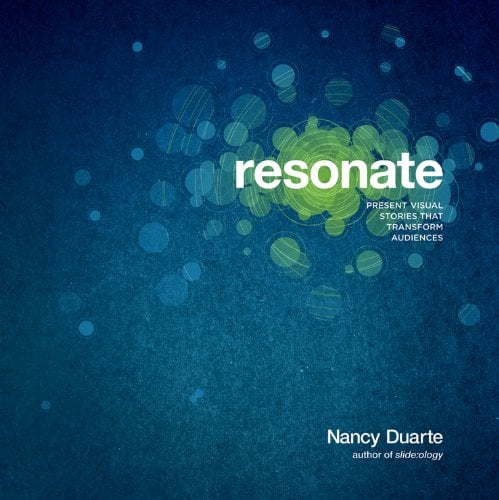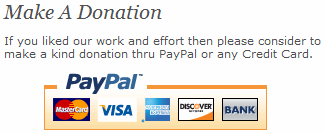Resonate: Present Visual Stories that Transform Audiences / Duarte, Nancy
| List Price: | |
Our Price: $25.57 | |
|
For Bulk orders
| |
|
Used Book Price: | |
| Resonate: Present Visual Stories that Transform Audiences / Duarte, Nancy | |
| Publisher: John Wiley and Sons | |
| Availability:In Stock. | |
| Sales Rank: 23332 | |
|
Similar Books
Product Description
Presentations are meant to inform, inspire, and persuade audiences. So why then do so many audiences leave feeling like they've wasted their time? All too often, presentations don't resonate with the audience and move them to transformative action.
Just as the author's first book helped presenters become visual communicators, Resonate helps you make a strong connection with your audience and lead them to purposeful action. The author's approach is simple: building a presentation today is a bit like writing a documentary. Using this approach, you'll convey your content with passion, persuasion, and impact.
- Author has a proven track record, including having created the slides in Al Gore's Oscar-winning An Inconvenient Truth
- Focuses on content development methodologies that are not only fundamental but will move people to action
- Upends the usual paradigm by making the audience the hero and the presenter the mentor
- Shows how to use story techniques of conflict and resolution
Presentations don't have to be boring ordeals. You can make them fun, exciting, and full of meaning. Leave your audiences energized and ready to take action with Resonate.
Create a S.T.A.R. Moment
Presentation Tips from Resonate
Create a moment where you dramatically drive the big idea home by intentionally placing Something They’ll Always Remember—a S.T.A.R. moment—in each presentation. This moment should be so profound or so dramatic that it becomes what the audience chats about at the water cooler or appears as the headline of a news article. Planting a S.T.A.R. moment in a presentation keeps the conversation going even after it’s over and helps the message go viral.
Since you might be presenting to an audience that sees lots of presentations—like a venture capitalist or a customer who is reviewing several vendors—you want to stand out two weeks after you presented, when they’re making their final decision. You want them to remember YOU instead of all the other presenters they encountered.
The S.T.A.R. moment should be a significant, sincere, and enlightening moment during the presentation that helps magnify your big idea—not distract from it.
There are five types of S.T.A.R. moments:
• Memorable Dramatization: Small dramatizations convey insights. They can be as simple as a prop or demo, or something more dramatic, like a reenactment or skit.
• Repeatable Sound Bites: Small, repeatable sound bites help feed the press with headlines, populate and energize social media channels with insights, and give employees a rally cry.
• Evocative Visuals: A picture really is worth a thousand words—and a thousand emotions. A compelling image can become an unforgettable emotional link to your information.
• Emotive Storytelling: Stories package information in a way that people remember. Attaching a great story to the big idea makes it easily repeatable beyond the presentation.
• Shocking Statistics: If statistics are shocking, don’t gloss over them; draw attention to them.
The S.T.A.R. moment shouldn’t be kitschy or cliché. Make sure it’s worthwhile and appropriate, or it could end up coming off like a really bad summer camp skit. Know your audience and determine what will resonate best with them. Don’t create something that’s overly emotionally charged for an audience of biochemists.
S.T.A.R. moments create a hook in the audience’s minds and hearts. They tend to be visual in nature and give the audience insights that supplement solely auditory information.
Famous S.T.A.R. Moments
 |  |  |
| Richard Feynman Richard Feynman helped investigate the space shuttle Challenger disaster. He quickly identified the failure of a crucial O-ring as the probable cause of the explosion. To illustrate his point, he bent and clamped a piece of the rubber O-ring and secretly placed it in a cup of ice water. At a perfectly timed moment, he loosened the clamp and as the rubber slowly uncurled he said, “…[F]or more than a few seconds, there is no resilience in this particular material when it is at a temperature of 32 degrees.” The press went nuts because it should have expanded in a millisecond. | Bill Gates Through his philanthropy, Bill Gates hopes to solve some of the world’s biggest problems, including malaria. In his 2009 TED talk, Gates established the gravity of this disease by stating that millions have died, and 200 million people are suffering from it at any given time. He then stated that more money is spent developing baldness drugs on behalf of wealthy men than on fighting malaria for the poor. At that moment, he released a jar of mosquitoes into the room saying, “There’s no reason only poor people should have the experience.” | Steve Jobs Steve Jobs is a master at unveiling Apple products in intriguing ways. “This is the MacBook Air,” he said in January 2008, “so thin it even fits inside one of those envelopes you see floating around the office.” With that, Jobs walked to the side of the stage, picked up one such envelope, and pulled out a MacBook Air. The audience went wild as the sound of hundreds of cameras clicking and flashing filled the auditorium. “You can get a feel for how thin it is. It has a full-size keyboard and full-size display. Isn’t it amazing? It’s the world’s thinnest notebook,” said Jobs. |
Case Study: Michael Pollan
Memorable Dramatization
 |
Michael Pollan is a natural storyteller who teaches people where food comes from. His books, The Omnivore’s Dilemma and In Defense of Food, have reshaped how Americans think about the current food system.
When Pollan spoke at Pop!Tech in the fall of 2009, there was one point in particular where he wanted to leave a deep impression on the audience. He and his team had calculated how much crude oil it takes to create a fast food double cheeseburger. It was a staggering amount, and he wanted that message to stick.
When he was introduced at the beginning of his presentation, Pollan walked on stage carrying a paper bag from a fast food chain. “A little something for later,” he said. He placed it on a table in the middle of the stage and started his presentation—thereby leaving the audience in suspense about the prop on the table.
Later, when Pollan was drawing connections between oil and the food supply, he said, “I want to show you how much oil goes into producing this [cheeseburger].” He pulled out the burger from the paper bag. Then he pulled out an empty eight-ounce glass and a container full of oil. He filled the glass with oil. “But that’s not all. You need another eight ounces.” He reached under the table and pulled out a second glass. Then he did it again. And again. In all, it took twenty-six ounces of oil to produce one double cheeseburger.
Showing the audience the burger next to the crude oil used to produce it was a disturbing visual—one that the audience would almost certainly remember the next time they made food choices.
From the Author: PowerPoint Templates for Presenting Abstract Ideas
Check out 10 PowerPoint templates to help illustrate abstract concepts.
Now you can buy Books online in USA,UK, India and more than 100 countries.
*Terms and Conditions apply
Disclaimer: All product data on this page belongs to  .
.
No
guarantees are made as to accuracy of prices and information.










